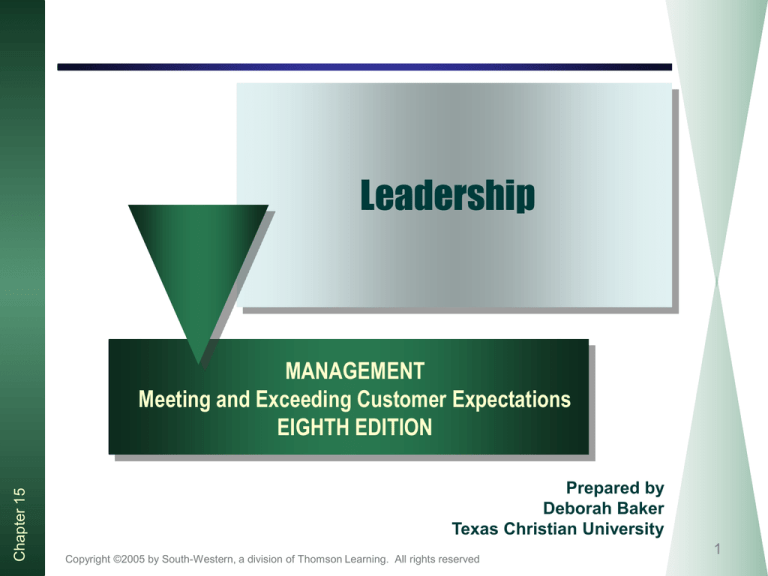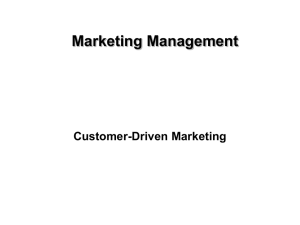
Leadership
Chapter 15
MANAGEMENT
Meeting and Exceeding Customer Expectations
EIGHTH EDITION
Prepared by
Deborah Baker
Texas Christian University
Copyright ©2005 by South-Western, a division of Thomson Learning. All rights reserved
1
learning objectives
1. Discuss leadership traits, skills, and behaviors
2. Differentiate between management and
leadership
3. Describe the five sources of power leaders may
possess
4. Differentiate between positive and negative
motivation
5. Describe the three decision-making styles used
Chapter 15
by leaders
Copyright ©2005 by South-Western, a division of Thomson Learning. All rights reserved
2
learning objectives (continued)
6. Explain the two primary approaches leaders can
take: task centered and people centered
7. Describe the three theories of situational
leadership
Chapter 15
8. Discuss the three challenges facing leaders
Copyright ©2005 by South-Western, a division of Thomson Learning. All rights reserved
3
Leading
Establishing values, culture, and climate
Defining a mission
Identifying core competencies
Scanning environments
Sensing the need for change
Creating a vision for the future
Enlisting cooperation and support for the vision
Keeping people and processes focused on
satisfying various customers
Chapter 15
Unleashing the full potential from human
resources
Copyright ©2005 by South-Western, a division of Thomson Learning. All rights reserved
4
Those Who Practice Leadership…
Guide
Direct
Counsel
Coach
Chapter 15
Persuade
Copyright ©2005 by South-Western, a division of Thomson Learning. All rights reserved
Inspire others
5
Leadership and Influence
Leadership
Chapter 15
Influence
The process of influencing
individuals and groups to set
and achieve goals
The power to sway people to
one’s will or views
Copyright ©2005 by South-Western, a division of Thomson Learning. All rights reserved
6
Leadership Variables
The leader
Those being led
Chapter 15
The circumstances and situations they are facing
Copyright ©2005 by South-Western, a division of Thomson Learning. All rights reserved
7
Leadership Traits
Chapter 15
1
Traits
Skills
Adaptable
Alert to social environment
Ambitious & achievement-oriented
Assertive
Cooperative
Decisive
Dependable
Dominant
Energetic
Persistent
Self-confident
Tolerant of stress
Willing to assume responsibility
Cleverness (intelligence)
Conceptual ability
Creativity
Diplomacy and tact
Fluency in speaking
Knowledge about the group task
Organizational ability
Persuasiveness
Social ability
Copyright ©2005 by South-Western, a division of Thomson Learning. All rights reserved
8
Leadership Behaviors
1
Yukl’s Leadership Behaviors
Performance emphasis
Consideration
Inspiration
Praise-recognition
Structuring reward
contingencies
6. Decision participation
7. Autonomy-delegation
8. Role clarification
9. Goal setting
10. Training-coaching
11. Information dissemination
Chapter 15
1.
2.
3.
4.
5.
12.
13.
14.
15.
16.
17.
18.
19.
Problem solving
Planning
Coordinating
Work facilitation
Representation
Interaction facilitation
Conflict management
Criticism-discipline
Copyright ©2005 by South-Western, a division of Thomson Learning. All rights reserved
9
2
Management versus Leadership
People Who Have Both Leadership Ability
and Management Ability
Chapter 15
Leadership
Ability
Management
Ability
People Who Have
Leadership Ability
but Are Not Managers
Copyright ©2005 by South-Western, a division of Thomson Learning. All rights reserved
People Who Have
Management Ability
but Are Not Leaders
10
Chapter 15
2
Management versus Leadership
Management
Leadership
Planning and budgeting
Establishing direction
Organizing and staffing
Aligning people
Controlling and problem solving
Motivating and inspiring
Copyright ©2005 by South-Western, a division of Thomson Learning. All rights reserved
11
3
The Five Sources of Power
Legitimate
Chapter 15
Reward
Coercive
Expert
Copyright ©2005 by South-Western, a division of Thomson Learning. All rights reserved
Referent
12
3
The Five Sources of Power
Legitimate Power – derives from their positions
in their organizations
Coercive Power – result of the exercise of
legitimate power
Reward Power – the right to promise or grant
rewards, such as raises and promotions, is often
the result of exercising legitimate power
Expert Power – a person’s abilities, skills,
knowledge, and experience can exert influence
when others value them
Referent Power – related to the kind of personality
Chapter 15
or personal attractiveness
Copyright ©2005 by South-Western, a division of Thomson Learning. All rights reserved
13
4
Motivation Continuum
Opportunities for Advancement
Responsibility
Positive
Motivation
Recognition
Financial Rewards
Praise
Status
Threats
Negative
Motivation
Reprimands
Financial Penalties
Chapter 15
Suspension
Termination
Copyright ©2005 by South-Western, a division of Thomson Learning. All rights reserved
14
5
Decision-Making Styles
Autocratic
Style
Participative
Style
Free-Rein
Style
Chapter 15
Which style a manager chooses should
relate to the situation encountered.
Copyright ©2005 by South-Western, a division of Thomson Learning. All rights reserved
15
5
Leadership Styles and the
Distribution of Decision-Making Authority
Manager’s Exercise of
Authority
Subordinates’ Share of
Decision-Making Authority
Autocratic Style
Chapter 15
Manager makes
decision,
announces it,
and seeks
feedback
Participative
Style
Manager makes
decision with input
from subordinates
Copyright ©2005 by South-Western, a division of Thomson Learning. All rights reserved
Free-Rein Style
Subordinate
makes decision
subject to limits
set by boss
16
5
Autocratic Style
Managers must:
Know what needs to be done
Possess expert power
Face issues that they are best equipped to solve
Create solutions in which implementation does
not depend on others
Chapter 15
Desire to communicate through orders and
instructions
Copyright ©2005 by South-Western, a division of Thomson Learning. All rights reserved
17
Participative Style
5
Managers:
Share decision-making authority with
subordinates
Involves others and lets them bring their
viewpoints, talents, and experiences to bear
on an issue
Chapter 15
Use to resolve issues that affect more than
just the manager
Copyright ©2005 by South-Western, a division of Thomson Learning. All rights reserved
18
Free-Rein Style
5
Managers:
Rely heavily on delegation of authority
Set limits and remain available for consultation
Chapter 15
Hold participants accountable for their actions
Copyright ©2005 by South-Western, a division of Thomson Learning. All rights reserved
19
6
Emphasis of Task Orientation
Technology
Plans
Programs
Goals
Chapter 15
Methods
Deadlines
Getting the
work out
Copyright ©2005 by South-Western, a division of Thomson Learning. All rights reserved
20
6
Emphasis of People Orientation
Chapter 15
Teamwork
Relationships
Copyright ©2005 by South-Western, a division of Thomson Learning. All rights reserved
Mutual
Trust
21
Chapter 15
6
The Leadership Grid®
Source: This image is an adaptation of The Leadership Grid ® figure as it appears in The Power to Change, Rachel McKee and Bruce Carlson
(Austin: Grid International, Inc.), p. 16. Copyright © 1999 by Grid International, Inc. Reproduced by permission of the owners.
Copyright ©2005 by South-Western, a division of Thomson Learning. All rights reserved
22
7
Theories of Situational Leadership
Contingency
Model
Chapter 15
Path–Goal
Theory
Life-Cycle
Theory
Copyright ©2005 by South-Western, a division of Thomson Learning. All rights reserved
23
Chapter 15
7
Fielder’s Contingency Model
Copyright ©2005 by South-Western, a division of Thomson Learning. All rights reserved
24
7
House & Mitchell’s Path–Goal Theory
Leadership style is effective on the basis of
how successfully leaders support their
subordinates’ perceptions of:
Chapter 15
Goals that need to be achieved
Rewards for successful performance
Behaviors that lead to successful performance
Copyright ©2005 by South-Western, a division of Thomson Learning. All rights reserved
25
7
House & Mitchell’s Path–Goal Theory
Leaders can influence subordinates’ motivation by:
1. Teaching employees competencies needed
2. Tailoring rewards to meet employees’ needs
Chapter 15
3. Acting to support subordinates’ efforts
Copyright ©2005 by South-Western, a division of Thomson Learning. All rights reserved
26
7
Assumptions of Path–Goal Theory
1. A leader’s behavior is acceptable and satisfying
to subordinates to the extent that they view it as
either an immediate source of satisfaction
or as an instrument to some future satisfaction.
Chapter 15
2. A leader’s behavior will increase subordinates’
efforts if it links satisfaction of their needs to
effective performance and supports their
efforts to achieve goals.
Copyright ©2005 by South-Western, a division of Thomson Learning. All rights reserved
27
7
Path–Goal Theory Leadership Behavior
Instrumental behavior
(task-oriented)
Supportive behavior
(employee-oriented)
Participative behavior
(employee-oriented)
Chapter 15
Achievement-oriented behavior
(employee-oriented)
Copyright ©2005 by South-Western, a division of Thomson Learning. All rights reserved
28
7
Path–Goal Theory Situational Factors
Personal characteristics of subordinates
Chapter 15
Work environment
Copyright ©2005 by South-Western, a division of Thomson Learning. All rights reserved
29
7
Path–Goal Theory Situational Factors
Personal Characteristics of Subordinates
Abilities
Personal Needs
and Motivations
Self-Confidence
Chapter 15
Perception of
Leaders
Copyright ©2005 by South-Western, a division of Thomson Learning. All rights reserved
30
7
Path–Goal Theory Situational Factors
Work Environment
Culture and
Subculture
Management
Philosophy
Chapter 15
Policies
and Rules
Copyright ©2005 by South-Western, a division of Thomson Learning. All rights reserved
Exercise of
Power
Structure
of Tasks
31
7
Hersey & Blanchard’s Life-Cycle Theory
Chapter 15
Life-Cycle
Theory
A view of management that
asserts that a leader’s behavior
toward a subordinate should
relate to the subordinate’s
maturity level. The focus on
tasks and relationships should
vary as the subordinate matures.
Copyright ©2005 by South-Western, a division of Thomson Learning. All rights reserved
32
7
Hersey & Blanchard’s Life-Cycle Theory
Autocratic
Participative
Chapter 15
New
Employees
Copyright ©2005 by South-Western, a division of Thomson Learning. All rights reserved
Free-Rein
Experienced
Employees
33
8
Leadership Challenges
Leadership must be exerted
throughout an organization
Leadership must respond rapidly
Leadership must make difficult
Chapter 15
decisions
Copyright ©2005 by South-Western, a division of Thomson Learning. All rights reserved
34







